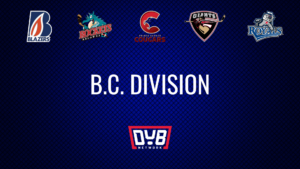The Portland Winterhawks 68-game schedule is half complete, and I’ve taken a glance at the numbers to spot anything which catches my eye.
For this report, I only included active roster skaters. Any players no longer on the team whether by trade, release, or any other reason are not included.
Isaiah DiLaura, Dante Giannuzzi, and Joel Hofer are not included in the offensive numbers but rather have their own section.
Later in my report, I hand out mid-season awards and quickly touch on the upcoming trade deadline.
16’s – O’Brien, Klassen, Stefan
17’s – Fromm-Delorme, Hanas, Jarvis, Knak, Kozak, Smythe
18’s – Brøndberg, Dureau, Gervais, Hanus, Newkirk, Nolan
19’s – Cicek, Ludvig, Mannek
20’s – Gilliss, Gricius, Quigley
A first glance at the main statistics broken down by age:


Goals:
When I reviewed the first 19 games, the Winterhawks were on track to score 244 goals this season. After 34 games, if Portland were to keep the same pace, this number would increase to 254. This is slightly fewer than the Winterhawks scored in 2018-2019 when they posted 258. One area that stands out though is the balance of their scoring this year compared to last season.
Through the first 17 games, Portland was averaging 3.58 goals-per-game, but they have increased to 3.73 during the second quarter of their season.
One of the areas of strength for the Winterhawks in the first portion of their season was scoring from the blue line. The six returning rear guards had a combined 16 goals through 17 games. Now, with 34 games under their collective belt, 28 goals have come from the group led by associate coach Kyle Gustafson.
While still producing, Clay Hanus (.29 to .24) and Johnny Ludvig’s (.47 to .32) goals per game have dropped slightly.
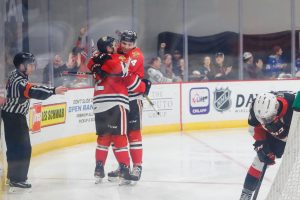
Reece Newkirk and Jake Gricius have picked up their goal scoring over the last 17 games. Averaging .29 goals per game during the first stretch, Newkirk has elevated his output to .44 with half the season remaining. Gricius raised his numbers from .29 to .35 goals per game.
The 17-year-olds continue to lead the way in terms of goals scored. However, some of the other age groups have closed the gap. At the time of my last report, 39.3% of Portland’s goals came from players born in 2002. Now, before Tuesday’s game against Seattle, the number is down to 32.8%.
The 16-year-olds now have 8.8% of the goals, up from only 3.3%. The 18-year-olds, led by Newkirk, increased by almost 7% (21.3% to 28%). The 2000-born skaters dropped from 19.7% to 14.4% while the overagers stayed flat (16.4% to 16%).
16-year-old rookie Gabe Klassen’s first 13 games have been impressive so far. After spending the first portion of the season with the Prince Albert Mintos, Klassen has registered four goals in his short time with the Winterhawks.
Seth Jarvis continues to lead the team in goals with 15 during the first half of the 2019-2020 season. During the time since the last review, he sustained an upper-body injury which required him to miss a couple of games. The 2020 NHL Draft eligible prospect has played in 31 of the team’s 34 games.
Portland has five players with at least double-digit goals through 34 games: Jarvis, Newkirk (14), Gricius (12), Ludvig (11), and Cross Hanas (10). Prior to Monday’s games, only six other WHL teams could boast the same accomplishment. Edmonton, Lethbridge, and Winnipeg each have six players with 10 or more goals. For perspective, Swift Current has none and Prince George, Tri-City, and Victoria only have one player in double digits.
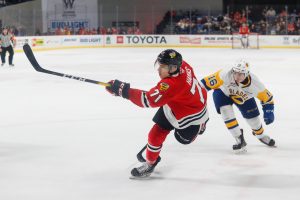
Hanas has feasted off of playing Tri-City, scoring four of his ten goals against the Americans. The young Texan also has a game-winning goal against Tri-City. He is currently on pace to score 20 goals, which is nothing to sneeze at. However, I wonder if he is looking to get closer to the 25-30 range.
Ludvig’s 11 goals rank him tied for first in the WHL among defenseman — an impressive accomplishment from the Winterhawks captain given some of the names patrolling the blue line. With eight goals, Hanus sits tied for 5th. The concern entering the season about Portland’s ability to score from the back end is no longer relevant.
Kishaun Gervais and James Stefan each picked up their first three goals in the WHL during the last run of games.
The story of the 2019-2020 season is scoring by committee. A perfect example: Portland has 24 wins, and 12 different players already have at least one game-winning goal. For perspective, the Winterhawks finished last season with 12 skaters having a GWG to their name. Newkirk leads the team with four, Jarvis has three, and Gricius, Robbie Fromm-Delorme, Hanas, Lane Gilliss, and Hanus each have two.
Assists:
Two assists can be awarded on every scoring play. Therefore, a total of 250 possible assists are available on Portland’s 125 goals (two goals are added for shootout wins). With half of the season completed, Portland has 220 assists across all players, good for 88% of the available amount. When compared to last year, the Winterhawks are on exact pace (446-of-506).
After 25% of the season, the 17- and 18-year-olds were tied at 37 assists each. The 2002s now hold a slight edge at 70-65.

Both the 16- and 19-year-olds increased their share of assists. Jack O’Brien, Klassen, and Stefan have a combined 12 assists which is 5.5% of the team’s total, up from 2.8% after 17 games. With 36 assists among Ludvig, Nick Cicek, and Mason Mannek, their portion raised from 12.8% to 16.4%. Lane Gilliss, Jake Gricius, and Matthew Quigley held steady (16.5% to 16.8%)
After 17 games, the Winterhawks had three players (Jarvis, Gricius, Dureau) within 3 assists of team leader Newkirk. With 34 games remaining, Newkirk has distanced himself from the pack now leading Gricius by 3 assists.
Newkirk is currently riding a ten-game point streak which is helping him keep his average of 0.81 assists per game alive. With 26 assists in his first season after being drafted by the New York Islanders, he is only ten shy of his total from last season. 14 of Newkirk’s 26 assists are primary which is a drop off from the first quarter where he had 10 of 14. The Moose Jaw, Saskatchewan, native continues to distribute the puck to a variety of skaters. 11 different Winterhawks have scored a goal assisted by Newkirk.
Jake Gricius has 23 helpers in his overage season and is on pace for his best season (34) in regards to assists. The Colorado Springs, Colorado, native’s assists are evenly distributed between primary and secondary, consistent with his first quarter of the season.
With 20 assists, Jarvis and Dureau are tied for third on the Winterhawks.
While Dureau’s goal-scoring numbers may be down, he hasn’t slowed down in picking up points via assists. At 0.71 per game in the first quarter, the 18-year-old is now sitting at 0.75. The power play continues to be an area of strength for Dureau as half of his assists have come while on the man advantage.
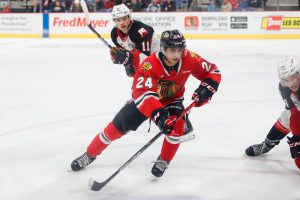
The upper-body injury for Jarvis may have set him back slightly in terms of production, but his projected point total has decreased from 88 down to 73. Missing games plays a factor into this, but his points per game dropped from 1.29 to 1.13. Teams have started to focus on shutting him down and sometimes playing man-on-man defense against him on the power play.
One player who raised the bar in the second quarter was Fromm-Delorme. Despite missing 7 games with an injury, the 2002-born winger is now producing 0.67 assists per game. When he returned from his Fromm-Delorme averaged an assist per game for eight games. How much does the Richmond, British Columbia, native drive the play? 14 of his 18 assists are primary. When Robbie registers a primary assist, the Winterhawks are 8-1-0-1. He has helped eight different Winterhawks to a goal. Gricius has benefited the most with four goals from Fromm-Delorme. Ludvig, Hanas, and Hanus have scored three times as a result of Robbie’s setup ability. Simon Knak has been assisted by Fromm-Delorme twice while Gilliss, Newkirk, and Kade Nolan have each scored once.
Tyson Kozak was the last of Portland’s 2002-born players to turn 17 as he has a late birthday of December 29. In his first 17 games this season, he registered two assists. The Souris, Manitoba, native kicked his play into high gear with eight assists over the next 17 games. Kozak went from 13th in team scoring to 10th as a result.
Mason Mannek also picked up eight assists during the second quarter of the season. The Utah native is now registering an assist every third game.
Plus/Minus:
Most are familiar with this statistic, but to be clear, players earn a “plus” if they are on the ice for a goal scored at even strength or when a shorthanded goal is scored by their team. Players receive a “minus” if they are on the ice for a goal against at even strength or when a shorthanded goal is scored by their opponent. Being on the ice for a power-play goal for or against doesn’t impact a player’s plus/minus rating.
Given how many variables factor into this statistic, many in the hockey community feel it isn’t the best representation of a player. They could just be jumping on or off the bench when a goal is scored, meaning they have no involvement in the goal. The player could also not be responsible for either the breakdown on defense or the zone time on an offensive shift.
That said, until a better one is provided and available, I will continue to review this statistic.

Every age group has increased its collective rating by a minimum of 14. The 16-year-olds were a -1 after the first review, but are now 14. The 2001s and 2002s each have six players, and they raised their ratings by 25 and 26 respectively. The three 19-year-olds showed the most improvement going from 13 to 47, a gain of 34. Finally, the overagers had a respectable 21 rise in their rating.
After 34 games, Portland does not have a single player in the negative; there were seven after 17 games.
Ludvig, as expected, leads the team with a +25 rating. The Florida Panthers draft selection went from 11 to 25 during the stretch of games.
Nick Cicek, who has been rotated with many different defensive partners, sits second with a +17, up from +6 on the last report.
Tyson Kozak (+12), Jake Gricius (+8), and Robbie Fromm-Delorme (+8) raised their ratings by nine points.
Power Play Statistics:
Prior to the games on Tuesday, December 31, Portland’s power play ranked fifth in the Western Hockey League at 23.1%. The Winterhawks have converted on 31 of their 134 man-advantage opportunities.
Last season, Portland finished sixth in the WHL with a 23.2% success rate, so they are on pace for what they accomplished a year ago.
In the second quarter of the season, the Winterhawks scored a power-play goal in 12 of 17 games. In the first quarter, they went seven games without a goal on the man advantage. Twice so far this season, Portland has scored three power-play goals in a game, both on the road — October 9 at Swift Current and December 4 against Prince George.
In games when Portland scores on the power play, the team has lost only five times this season.

11 different Winterhawks have a power-play goal. Jarvis leads the way with six, followed by Newkirk and Ludvig with five. Lane Gilliss has four goals on the man advantage. Hanus and Gricius each have lit the lamp three times on the power play.
Jaydon Dureau is the catalyst for Portland when up a man. His ten power-play assists leads the team with Ludvig only one behind. Dureau and Jarvis are often used for their speed to help with entry into the offensive zone.
Jake Gricius and Reece Newkirk each have eight assists and are key members of the Winterhawks top power-play unit.
16 different skaters have tallied at least one power-play assist so far.
Kyle Gustafson continues to update the power play throughout the season, preventing teams from keying in on any one specific player or look. One area of consistency though has been the use of four forwards and one defenseman on the top unit. Portland sustained several injuries up front during the second quarter of the season, so players were rotated through units as needed.
Penalty Kill and Shorthanded Goals:
Prior to the games on Tuesday, December 31, Portland’s penalty kill ranked top in the Western Hockey League at 87.5%, allowing only 18 power-play goals on 144 opportunities.
They were ranked 12th in the number of times shorthanded after 17 games and are 11th currently. The Winterhawks reduced the number of penalties taken per game from 4.35 to 4.24 — a trend they will want to continue as the games get tighter down the stretch.
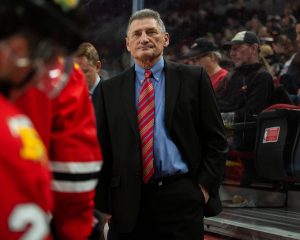
Don Hay’s penalty-killing units are led by Mason Mannek, Jake Gricius, and Lane Gilliss up front (other forwards are used as well). While ice time is not published, without a doubt Johnny Ludvig is the leader while shorthanded.
In the second quarter of the schedule, Portland allowed a total of nine goals. Only twice did the team allow more than one power-play goal in a game, both on the road — November 16 in Seattle and November 30 in Kamloops. On ten different occasions, Portland kept its opponent from scoring on the man advantage, one of which came in a game where they took seven penalties.
Portland has not scored any shorthanded goals in the last 17 games so no statistics have been updated.
Goaltending:
Again, Joel Hofer has been Portland’s top player. His first half of his season was so strong that it led to him making Hockey Canada’s World Juniors roster. When the tournament started, Hofer was the backup but made his first appearance against Russia. Afterwards, he started the next two games against Germany and the hosts Czech Republic.
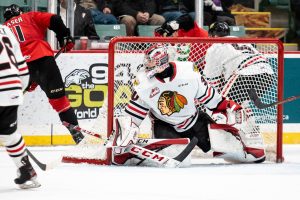
He left to represent his country with the league’s best save percentage at 1.81 and second in save percentage, stopping 93.7% of the shots he faced. Hofer is also the only WHL goalie with 20 wins entering Tuesday’s games.
Starting on November 17, the St. Louis Blues signed prospect started ten games in a row before leaving for Hockey Canada’s selection camp. During those ten games, Hofer stopped 286-of-301 shots (0.950 SV%), had a 1.48 GAA, and also included three shutouts.
Many questioned how Portland would fare without its number one goaltender.
With Hofer gone, Mike Johnston called up 17-year-old Dante Giannuzzi who was playing in the MJHL.
In the five games since Hofer has been away, Johnston rotated Giannuzzi with Isaiah DiLaura. The team picked up nine-of-ten points going 4-0-0-1 entering Tuesday’s game against Seattle.
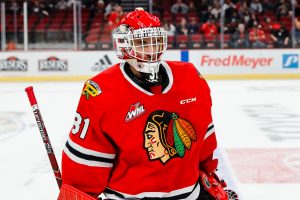
The duo of Giannuzzi and DiLaura has combined to stop 122-of-131 shots (0.931 SV%) and has a 1.74 goals-against average.
As a result of the strong play by both netminders, Portland has kept pace with the Everett Silvertips for the top spot in the U.S. Division.
Portland has a minimum of three, possibly four, games where they will be without Hofer. Strong play by DiLaura and Giannuzzi may be the difference in finishing first in the division come the end of the season, given how tight the standings are with Everett.
Mid-season awards:
These awards are 100% subjective and my opinion only. They do not mean anything and do not hold any weight.
MVP: Joel Hofer – Hard to argue with what he has given Portland night in and night out. Leads the league in wins and goals-against average and second in save percentage.
Runner Up: Johnny Ludvig – He is a shot blocking machine, leader of the league’s top PK unit, and also leads WHL defensemen in scoring.

Top Forward: Reece Newkirk – This one was tougher, given how stacked Portland is at forward, but I will give the edge to Newkirk. He has been consistent for Portland. Reece hasn’t taken over a game like Cody Glass, Joachim Blichfeld, and many other recent Winterhawks have, but he has become Mr. Reliable. A scary injury to his wrist turned into one that had him miss a week, rather than a season. Just how consistent is the 18-year-old forward? Opponents have only kept him off the scoresheet in six games.
Runner Up: Jake Gricius – Perhaps even harder was picking a runner up. I debated between a couple of players here. I tend to look beyond how many points a player scores and focus on what else they provide. Gricius is the number one center on this team, and he plays in every situation. Gricius has taken and won the most faceoffs in the league. He is a top penalty killer and is often matched up against the opponent’s top line. The Colorado Springs, Colorado, native is also a point-per-game player so he checks that box as well.

Top Defenseman: Johnny Ludvig – A throwback defender who also contributes offensively. His game has really elevated over the past couple of seasons.
Runner Up: Jonas Brøndberg – Another tough decision here, perhaps the most wide open of any of the superlative awards. A case could be made for a number of different guys, but Brøndberg for me rises to the top of the bunch. He is not a flashy player either offensively or defensively, but he quietly goes about his role on the second pair. Prior to the season, he had never played on NHL-sized ice before and has continued to progress in all aspects of his game. First year imports often take off after the holiday break. He will need a strong second half if he wants to hold this spot.
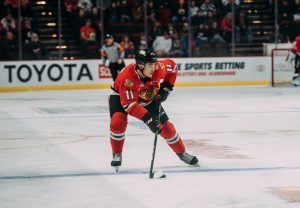
Most underrated/underappreciated: Robbie Fromm-Delorme – With Portland’s top names in the 2002 age group, he often went overlooked. He is a puck retriever and drives whatever line he plays on. He appeared in 60 games as a 16-year-old rookie a season ago and showed tremendous potential. So far, in his second season, Winterhawks fans are perhaps only seeing the start of something special. Taken in the seventh round of the WHL Bantam Draft, Fromm-Delorme has already eclipsed his point total from last year. When he was out of the lineup with his injury, Portland missed his grit along the wall, but also his play making ability.
Runner Up: Tyson Kozak – As much as Fromm-Delorme is overshadowed by the rest of his age group, Kozak is perhaps even more. His late birthday plays a factor into this, along with him playing five games last season. Kozak is quickly becoming one of Mike Johnston’s most trusted players. Kozak is often out in late-game situations protecting leads and is beyond reliable in his own zone. With six goals and ten assists in the first half, his offense is starting to blossom as well. Neither Kozak nor Fromm-Delorme should be forgotten when talking about Portland’s 2002-born forwards.

Most likely to have a strong second half: Jaydon Dureau – There is no doubt the 18-year-old has all of the tools to be a special player in this league. His assists and play-making are on point and in form currently, but I have to think there is more in that stick in terms of goal scoring. As a 17-year-old last season, he registered 12 goals and shot 14.4% which may have been unsustainable. That said, his current 7.3% is just as much unsustainable. I think he is closer to a 10-11% shooter which would see him finish around 16 goals. Given how Portland uses him on the power play and the way teams are starting to take away Seth Jarvis, he could improve on his one power-play goal.
Runner Up: Simon Knak – The import forward from Switzerland is already having a strong rookie season in the WHL with 18 points in 25 games played. Like Hofer, Simon is representing his country at the World Juniors. He scored his second goal of the tournament today which, as a 17-year-old in a 19-year-old tournament, is impressive. Mike Johnston always talks about how import players typically take off after the holiday break. Simon should return from World Juniors full of confidence and add some extra pop to Portland’s lineup.
Trade Deadline:
I want to quickly address the elephant in the room — the upcoming trade deadline on January 10.
The team is perhaps outperforming expectations as they sit tied with Everett atop the U.S. Division. Do they make a move? If so, what type of move do they make? Is it a move like acquiring a Lukus MacKenzie and Shaun Dosanjh or closer to a Dennis Cholowski?
Portland has four games prior to the deadline passing. They play in Victoria that night, but the deadline will already have passed. What do Mike Johnston and his front office staff decide to do?

Portland is facing many tough questions for next year — none bigger than whether they get Joel Hofer and/or Johnny Ludvig back next season as NHL-drafted overagers. If not, does Portland need to make use of them now? Their core players are 17- and 18-years-old, so many around town want to be careful to not impact future teams — a catch-22 situation.
The Western Conference is loaded.
Kelowna is hosting the Memorial Cup this year so the Rockets are likely not done upgrading their roster. Kamloops has a stockpile of high draft picks if it wants to acquire more talent. Vancouver is having a down year compared to the expectations the team had of making the league final a year ago. They may be looking for an upgrade or two. Everett is known to be looking for help up front, especially at center. What does Spokane do with its last season of having Ty Smith? Historically the team has not made major moves.
Portland does not have many high draft picks available after making some large moves the last two seasons. Will this limit what Johnston can pull off, assuming he does not want to part with current roster players?
More to come.
I will reexamine when the third quarter of the 2019-2020 season is complete on February 8 against Kelowna.

